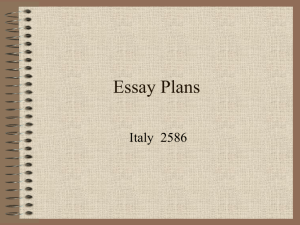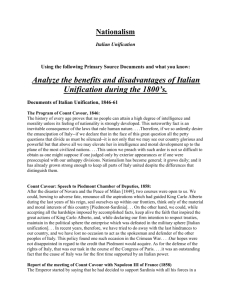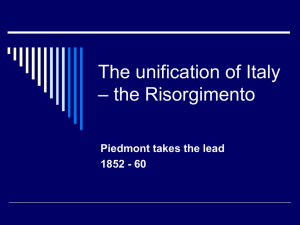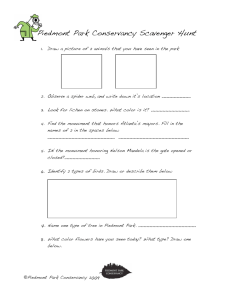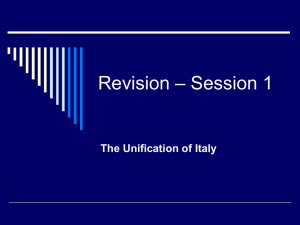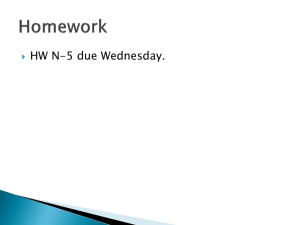Italian Unification: 1815-1870 - Key Events & Figures
advertisement
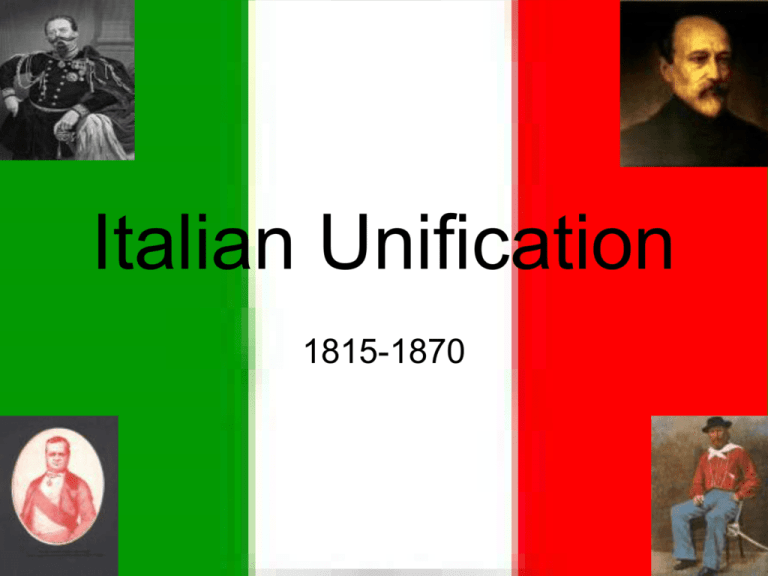
Italian Unification 1815-1870 Revolutions of 1820 • Naples – Ferdinand – Church – Financial problems – Withdrawal of Austrian garrison – Sicily – Carbonari – Example of revolt in Spain (Jan. 1820) Revolutions of 1820 contd • • • • • Garrison revolted in Naples (June, 1820) Leader: Gen. Guglielmo Pepe Ferdinand I promised constitution (July, 1820) Pepe appointed to lead new government Separate rising in Sicily demanding more autonomy; opposed by Pepe government • Rising discussed at Congress of Troppau • Ferdinand attended Congress of Laibach and asked for assistance in suppressing revolt Naples 1820 contd • Rising suppressed by Austrian troops with diplomatic support from Russia and Prussia • Followed by vicious suppression by Ferdinand’s restored government Piedmont, 1820-21 • • • • Victor Emmanuel I restored in 1815 Strengthened by addition of Genoa All French reforms suppressed Growth of support for Carbonari especially after Naples rising • Student riots in Turin (Jan), military revolt (Mar) forced abdication of Victor Emmanuel • Charles Albert vs Charles Felix • Austrian repression Revolutions of 1831 • Effects of July Revolution in France: “When Paris sneezes, Europe catches cold…” • February, 1831: liberal risings in Modena and Parma; savagely repressed by Duke Francis of Modena by end of March • Various uprisings throughout Papal States during 1831-32 suppressed by Austrian and Papal forces Reasons for Failure in 1821 & 1831 • No support from Louis Philippe • No support from Great Britain • Weakness of Carbonari – Isolated groups; no coordination – Middle class support only • No mass support for liberalism or nationalism • Strength of Austria and Metternich Il Risorgimento • Early calls for Italian nation during French Revolution (eg. Alfieri, Denina) • Guiseppe Mazzini – – – – – From Genoa Joined Carbonari in 1827 Arrested and imprisoned in 1830 Rejected Carbonari aims Founded Young Italy (1831) Mazzini’s Nationalism • • • • Strongly believed in God, but not in Church Believed in individual rights, but also in duties Believed in equality of men and races Pledged to create “one, free independent republican nation” in Italy • Cooperation with constitutional monarchies was just a tactical move on the way to the end of a unitary republic • Armed revolution national regeneration Mazzini, contd • Organized revolt after revolt, all of them failures, some of them ridiculously so • Came to personify the Risorgimento throughout Italy • Popularized Italian cause throughout Europe and America • Helped create the idea of Italy Other roads to national unity • Vincenzo Gioberti and the Papacy – Of the Moral and Civil Primacy of the Italians (1843) – Proposed Italian federation under leadership of the Pope since church was fundamental institution in Italian life"Del primato morale e civile degli Italiani" – Book sold widely and was generally well-received; seen as more moderate alternative to Mazzini’s republicanism, BUT • Papal States were among most backward and repressive parts of Italy • Pope showed no interest in his ideas Pius IX and Italian Unification • Elected in 1846; known to have liberal sympathies • Elected unexpectedly • Granted amnesty to all political prisoners • Proposed reforms to administration, education and legal systems giving laymen more role • Ended press censorship • Sponsored formation of civic guard to protect property and prevent violence Pius IX contd • Proposed customs union with Piedmont and Tuscany (1847) • Resisted Austrian attempts to extend garrison rights in Ferrara • Initially, seemed favorable to Italian cause during 1848 disturbances BUT: • His intervention against revolutionary change was an important factor in their failure. 1848 Revolutions • Causes – Liberal demands for constitutions – Unpopularity of Austrians – Harvest failures in 1846 and 1847 – Reforms in Papal States – Influence of Mazzini 1848 Revolutions contd • Revolts in Sicily and Naples (January) • Sicilians wanted independence from Naples – had taken over most of island by April • In Naples, King Ferdinand II agreed to share power with a parliament but hung on to most of his power • Ferdinand used excuse of rioting to appoint right-wing government (May) • In September, sent troops to re-take Sicily • Ferdinand abolished all reforms made since January 1848 1848 Revolutions contd • Tuscany and Piedmont offered limited constitutions (Feb); constitution revolts in Parma and Modena • Tobacco boycott in Milan (Lombardy) “The Five Days” (March 17-22) of riots and fighting. • Due to disturbances and fall of Metternich in Vienna, Radetsky removed troops from Milan • Revolutionary provisional government appealed to Charles Albert for help • Charles Albert declared war on Austria • March 22: Independent Republic of St Mark (Venice) 1848 Revolutions cont’d • May: Commander of Papal troops marched to support Charles Albert widespread belief that anti-Austrian movement had support of Pope • Pope made declaration “repudiating… those who would have the Roman Pontiff to be the head … of some sort of novel Republic of the whole Italian people.” • Nationalist movement began to take on anticlerical character • July: Austrians defeated Charles Albert at Battle of Custozza. Charles Albert signed armistice and withdrew to Piedmont 1848 Revolutions contd • July: Mazzini arrived back in Italy. Declared “war of the princes” over and “war of the people” to begin. • November: Chief Minister of Papal States assassinated; Pope fled to Naples; new government called for representatives from all over Italy to attend a constituent assembly in Rome • Assembly met in Feb. 1849 – Garibaldi was one of the deputies • March: Mazzini elected head of Triumvirate to run government of Roman Republic 1848 Revolutions contd • Pope appealed for help from France, Spain and Naples to suppress republic • New French Republic sent 20,000 troops to put Pope back on throne • City defended against great odds by volunteers led by Garibaldi • City captured by French troops end of June, 1849 1848 Revolutions contd • March 1849: Charles Albert denounced armistice and went to war with Austria again • April 1849: heavily defeated at Battle of Novara; abdicated in favor of son, Victor Emmanuel II • May-June 1849: Austrian troops defeated revolutionary governments in Tuscany, Modena and Parma • August 1849: Venice surrendered to besieging Austrian forces. Why did the 1848 Revolutions Fail? • Lack of unity between different groups – Sicilians and Neapolitans – Manin refused to send representatives to Roman Constituent Assembly – Attitude of Charles Albert – No recognized national leader (Pope, Charles Albert, Mazzini??) or nationalist ideology • Inexperience of provisional governments • Little or no popular support (no land reform, no social reform) Positive Effects of 1848 Revolutions • Helped create “Italian national mythology” (heroic defense of Rome by Garibaldi, Venice by Daniel Manin) • Established constitutional monarchy in Piedmont • Eliminated Papacy as alternative focus of national aspirations • Established Piedmont and Savoy Dynasty as sole defender of national dream Cavour and Italian Unification • Austria didn’t insist on territorial compensation after Novara – believed this, or forcing return to absolutism, might play into hands of nationalist republicans • Thousands of nationalist and liberal refugees flooded into Piedmont (20,000 in Genoa alone) and influenced domestic politics • Count Camillo di Cavour became member of Piedmont parliament in 1848 • Supported the “middle way” between radical (Mazzini) nationalists and absolutism and reaction • Appointed Minister of Trade and Agriculture in 1850, Prime Minster in 1852 • Brought in series of reforms including: state railroads, reducing customs duties, encouragement of agricultural improvement, founding of state savings banks • Trade doubled during the 1850s • Attacked power of Church as “impediment to social progress” • Used bribery, chicanery and shady political deals to maintain his majority Cavour contd Foreign Policy • Participation in Crimean War – No vital Sardinian interests involved – Brought Piedmont benefits: • Sympathy from Britain and France • Gave Piedmont seat at Paris Peace Conference at which she could push Italian interests • Split Austrians and Russians Cavour contd • Cavour & Napoleon III – Assassination attempt by Felice Orsini (Jan. 1858) – Napoleon allowed publication of Orsini’s letter to him from condemned cell – July 1858: Cavour & Napoleon met at Plombieres Cavour contd The Plombières Agreement – France would join Piedmont in a “defensive” war against Austria – Piedmont would annex Lombardy, Venetia, Parma and Modena – Napoleon III’s cousin, Prince Napoleon, would marry Victor Emmanuel II’s daughter – France would get Nice and Savoy from Piedmont Plombières Agreement contd (After that, it all gets a bit vague – not stated clearly at all) – Piedmont might get northern Papal States (Romagna) – Overthrow of Ferdinand in Naples might see the throne pass to Lucien Murat – Pope might be made head of new Italian Confederation – French (Bonaparte) candidate might be made King of Central Italy (including part of Papal States and Tuscany) Franco-Austrian War (1859) • Pressure from GB & Russia forced Napoleon to give demobilization order and agree to international congress to discuss Italy • Austria issued ultimatum to Piedmont demanding immediate disarmament • This alienated GB so Napoleon was again able to mobilize and then attack Austria • Invading army: 200,000 French, 63,000 Piedmontese • Won bloody battles at Magenta and Solferino in June • July: Napoleon agreed separate peace with Austria at Villafranca which only gave Piedmont Lombardy Villafranca Terms • Austria ceded Lombardy (except Mantua and Peschiera) to France – France would then transfer it to Piedmont • Rulers of Central Duchies would return as part of a confederation under Pope, but no force could be used to enforce this • No mention of Nice and Savoy • Meanwhile, in Parma, Modena and Romagna,Luigi Farini (ex-education minister under Cavour and later minister of commerce) declared himself dictator of “Emilia” and called for incorporation under Victor Emmanuel • Bettino Ricasoli, another Cavour ally, did same in Tuscany. Franco-Austrian War (1859) contd • Why did Napoleon III stop short? – Appalled by loss of life at Magenta and Solferino – Piedmont had supplied only 1/3rd of 100,000 troops promised – Piedmontese agents were active in Tuscany and the Papal States trying to arrange “spontaneous” popular risings demanding incorporation into Piedmont – Napoleon didn’t want to see a united Italy: “I will not have [Italian] unity… France would not be pleased to see rise beside her a great nation which might diminish her preponderance” – Worried by signs that Prussia might exert pressure on behalf of Austria Franco-Austrian War (1859) contd • Cavour resigned (July, 1859) in protest when Victor Emmanuel II refused to continue war alone • Elected assemblies in Modena, Tuscany, Parma and Romanga voted for incorporation into Piedmont • Cavour returned to power (Feb, 1860) and did deal with Napoleon III (Treaty of Turin, March, 1860): France would agree to incorporation of Central Italy into Piedmont, Piedmont would cede Nice and Savoy to France • Plebiscites to confirm deal – probably rigged – held in March-April, 1860 Cavour’s Plans in 1860 • Cavour recognized that Mazzini’s National War of Liberation was not a realistic option • Piedmontese expansion into the leading Italian power could only come about with support of larger European powers, especially France • France was only likely to support Kingdom of Northern Italy under Victor Emmanuel; not likely to support further expansion • Cavour probably wanted to stop and consolidate after annexation of Central Italy • “I omitted nothing to persuade Garibaldi to drop his mad scheme” Garibaldi and Cavour • In March, 1860, Garibaldi was considering an armed expedition to Nice to prevent incorporation into France • Disliked and mistrusted by Cavour – Garibaldi seizure of Southern Italy might lead to demands for united republican Italy • Premature establishment of united Italy might precipitate French and Austria intervention • By 1860, Cavour probably saw unification as “historically inevitable” but favored caution The Sicilian Revolt • Started in Palermo, April 4, 1860 • Led by Crispi & Pilo (Mazzini republicans) • No support from Cavour • Supported by peasants demanding land reform • Garibaldi stole two ships in Genoa and sailed with 1000 volunteers to help rebels • Cavour certainly didn’t help Garibaldi; historians divided as to how much he hindered • By May 30 had captured Palermo and forced surrender and withdrawal of royal troops • Cavour even more worried by prospect of invasion of Naples Invasion of Naples • “If Garibaldi crosses over to the mainland and seizes the Kingdom of Naples … he becomes the master of the situation. King Victor Emmanuel loses more or less all his prestige; in the eyes of the great majority of Italians he is no more than Garibaldi’s friend. With the resources of a kingdom of nine million inhabitants at his disposal, surrounded as he is by irresistible popular prestige, it is impossible for us to struggle against him.” • Garibaldi invaded on August 22; on September 6, king fled and Garibaldi’s troops occupied Naples • Garibaldi clearly intended to pursue defeated Neapolitan troops into Papal States and unite Italy… Cavour’s Reaction • September 12th: having stirred up unrest in the Papal States, Cavour informed the powers that Piedmont would be obliged to intervene to restore order! • Defeated Papal troops at Castelfidardo and occupied all the Papal States except Rome itself • At Teano (near Naples) Garibaldi met Victor Emmanuel and agreed to hand over his conquests to him (October 26) • Plebiscites in Naples, Sicily and Papal States voted for incorporation into a Kingdom of Italy under Victor Emmanuel II; essentially, Piedmont had annexed the rest of Italy! • Thus the Kingdom of Italy now covered all Italy except Venice and Rome. Completion of Unification Venice • Two attempts by Garibaldi’s followers to foment uprisings (1862 and 1864) failed • In 1865, the Italian government offered to buy Venetia from the Austrians; rejected • April, 1866: military alliance with Prussia which would give Italy Venetia in return for help in war against Austria • Defeated on land (Custozza) and at sea (Lissa) • Prussian victory at Sadowa cession of Venetia Completion of Unification, contd Rome • Garibaldi attempted to add Rome to Italy twice (1862 & 1867) but failed because – Opposed by Piedmont – No support from local population – Presence of French troops
